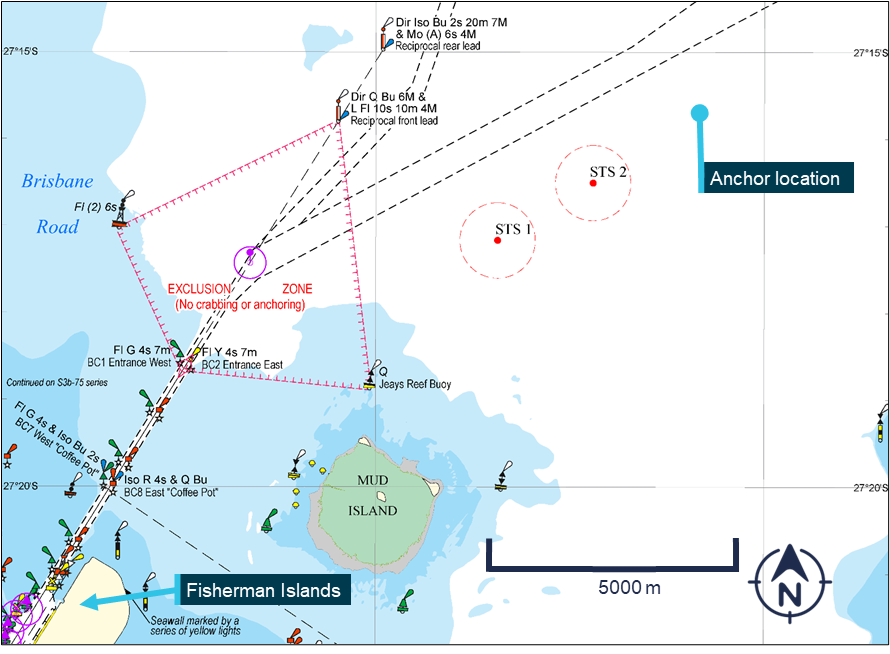What happened
At 2306 local time on 1 July 2025, 2 pilots boarded a 316 m container ship at the Mooloolaba pilot boarding ground for its transit through Moreton Bay to the port of Brisbane. Wind speeds during the day had exceeded the limits for berthing this size and type of ship and the pilots expected that it would be required to anchor at the inner anchorage. They planned to stay on board until later the following morning when a pilot launch would be available.
At 0200, one of the pilots checked with Brisbane vessel traffic service (VTS) and was informed that the weather conditions remained unsuitable for the ship’s berthing and advised that it be anchored in the inner anchorage. At 0236, the ship was anchored in a position to the north‑east of the STS‑2 anchorage (Figure 1).
At the same time, the pilot launch was at the anchorage with the pilots of 2 ships that had anchored earlier. While the launch had been scheduled to return to base, a decision was made to delay its return to allow the pilots of the container ship to disembark.
At 0255, after confirming that the anchor was holding, the officer of the watch escorted the pilots from the bridge for disembarking via the pilot ladder. The pilot ladder was properly rigged through the access door on the ship’s starboard side and it appeared to be in good condition. Weather conditions at the time were a 25-knot[1] westerly wind gusting to 30 knots and short, choppy seas with an average wave height of about 2 m.
As the tide was close to slack water,[2] the ship was riding to the wind and its yawing[3] intermittently exposed both the port and starboard sides to the weather. This meant that its hull did not provide adequate shelter (a lee) to the pilot launch, and the launch master found conditions unacceptable for a transfer when attempting to come alongside.
Consequently, the launch master asked the ship’s master (via radio) to provide a better lee. The ship’s main engine, rudder and bow‑thruster were then used to bring the wind on its port bow. This created a partial lee on the starboard side (considered marginal, but acceptable, by the launch master).
At about 0310, one pilot descended the ladder with a careful eye on the launch’s motion in the waves and stepped onto its deck. At the same time, a large wave pushed the launch away from the ship’s side, putting the pilot in a precarious position. The launch deckhand was unable to hold onto the pilot, who then slipped off the deck and fell overboard.
The pilot’s personal floatation device (PFD) inflated immediately and the launch master quickly manoeuvred clear and activated the man overboard procedures. This included deploying lifebuoys from launch and ship, but these were beyond the pilot’s reach. The launch master then moved it close to the pilot, which allowed the deckhand and the other pilots on board to recover the pilot using the stern‑mounted rescue scoop.
The pilot transfer operation was suspended and, after recovering the lifebuoys from the water, the launch began its return to base. The other pilot remained on board the ship to wait for weather conditions suitable for disembarking.
The recovered pilot was not injured but was feeling cold and exhausted. With no blankets or towels on board, the launch crew improvised with available clothing to keep the pilot warm while the launch made its way ashore. Once landed, the pilot was transported to hospital for treatment and confirmed to have no injuries.
Figure 1: Brisbane inner anchorage

Source: Maritime Safety Queensland, annotated by the ATSB
Safety action
The pilotage provider’s internal investigation into the incident resulted in various proactive safety actions, including:
- promulgating lessons learned to its pilots and launch crews, with an emphasis on the need for greater care for pilot transfers at anchor and reiterating the need to stop the operation if anyone involved felt the conditions are unsuitable
- developing a formalised approach to assess transfer risk at the inner anchorage in consultation with the harbour master
- strengthening overboard rescue preparedness through refresher drills for launch crew and in-water survival training for pilots
- providing thermal care kits to launches and updating casualty care procedures.
Safety message
Pilot transfer via ladder continues to be a high‑risk operation, with associated incidents often resulting in serious or fatal injuries. Even when the equipment is in good condition and rigged correctly, environmental conditions must be carefully considered before starting the transfer. The responsibility for assessing suitability of the conditions rests with both the launch crew and the pilot(s), and both have the authority to stop the transfer in case of doubt.
Transfers from anchored ships involve additional risks, as they may not be able to provide a suitable lee and yawing may expose either side of the ship to the weather, making timing of the operation critical. In addition, pilot launches and their arrangements are designed for transfers while the ship is underway when the speed through the water allows the launch to be pushed up against the ship’s hull. This advantage is lost when the ship is at anchor when the launch is prone to being pushed away from the hull by waves, which also exacerbates unpredictable vertical motion.
About this report
Decisions regarding whether to conduct an investigation, and the scope of an investigation, are based on many factors, including the level of safety benefit likely to be obtained from an investigation. For this occurrence, no investigation has been conducted and the ATSB did not verify the accuracy of the information. A brief description has been written using information supplied in the notification and any follow-up information in order to produce a short summary report, and allow for greater industry awareness of potential safety issues and possible safety actions.


